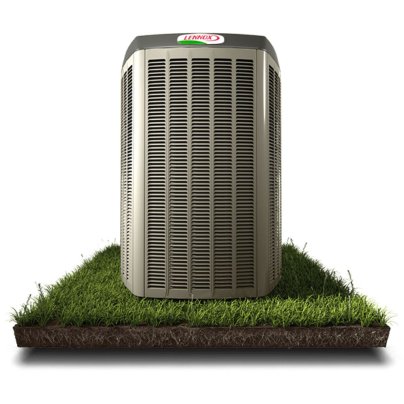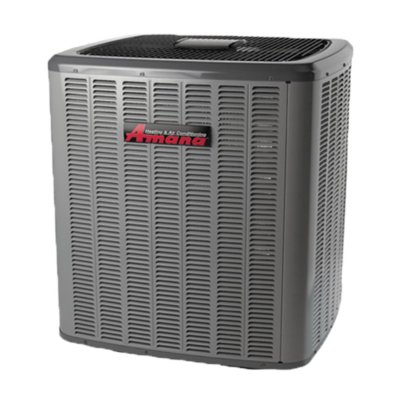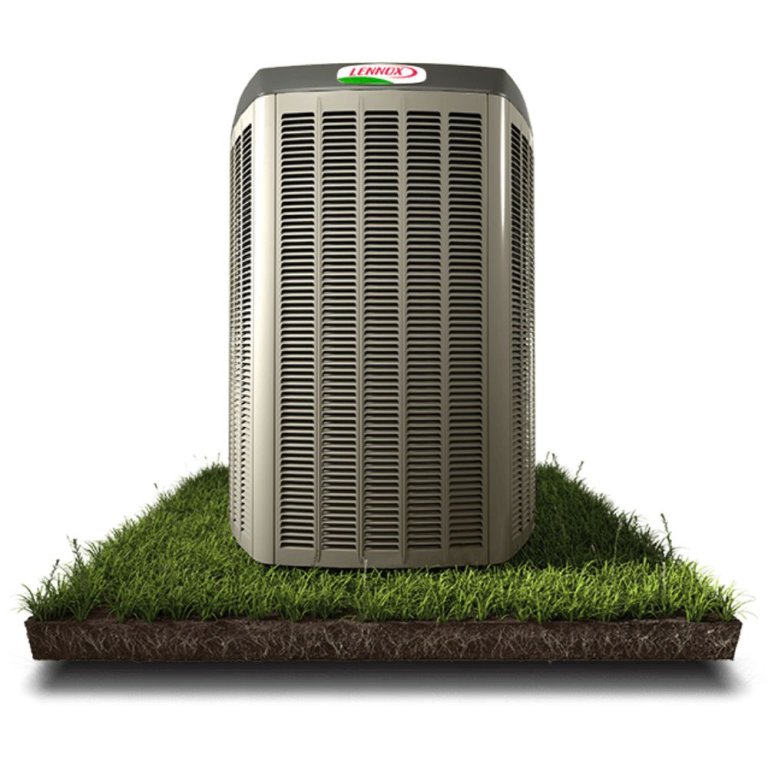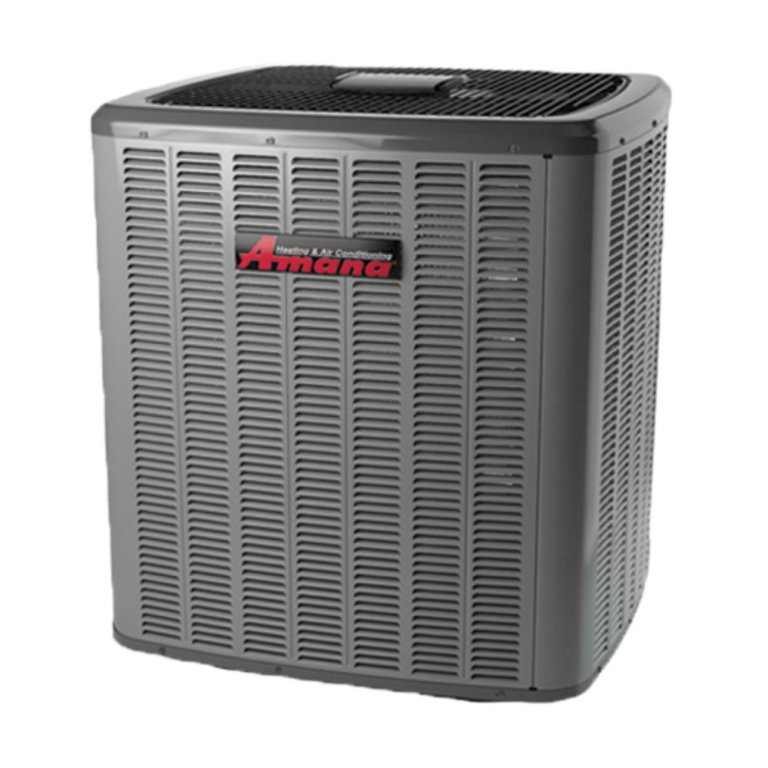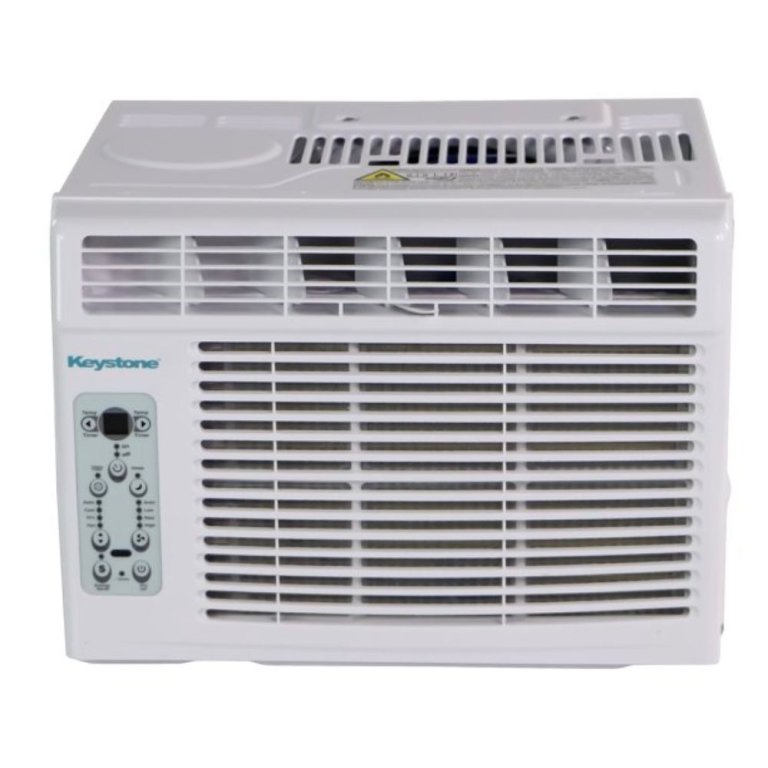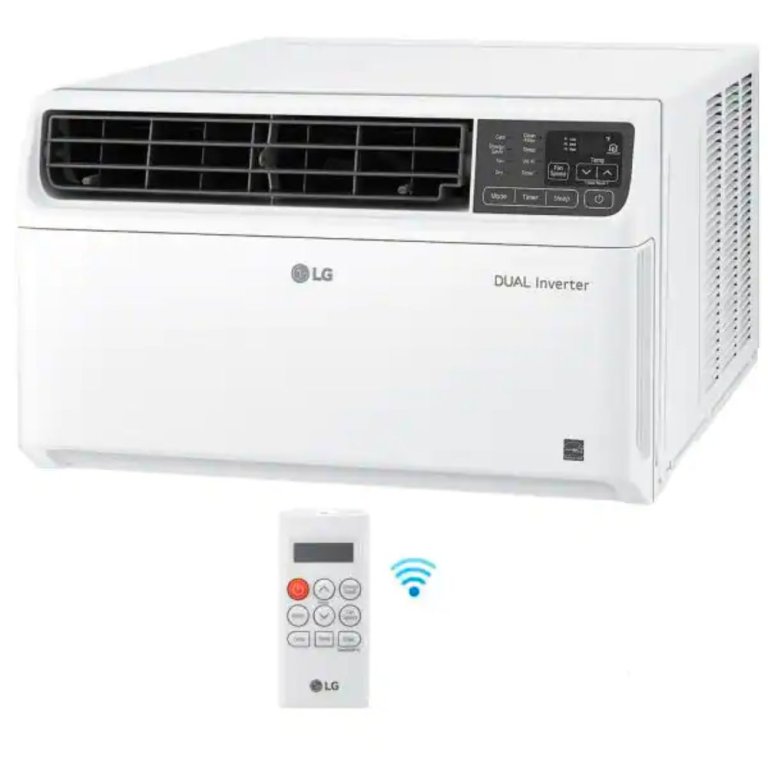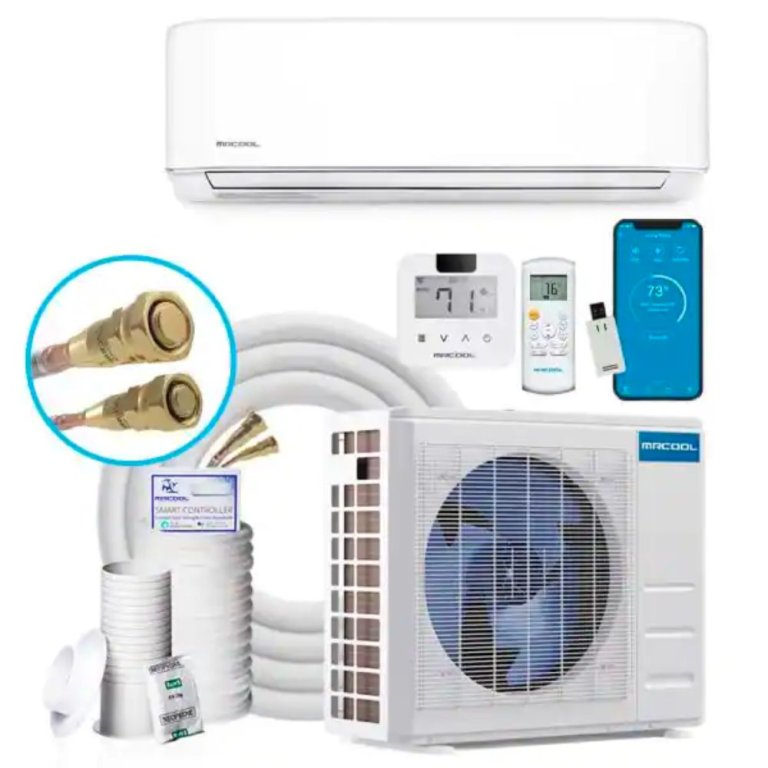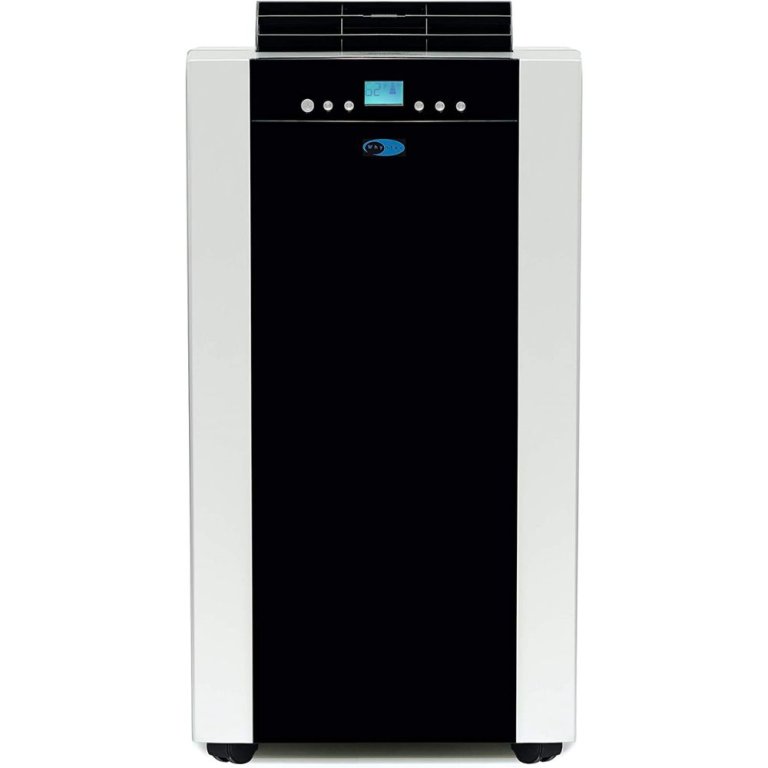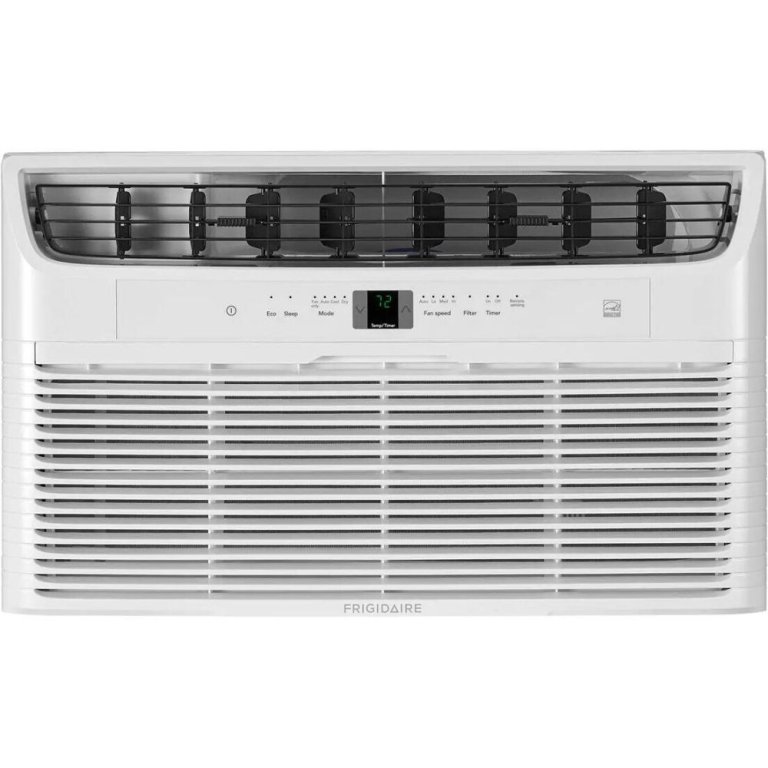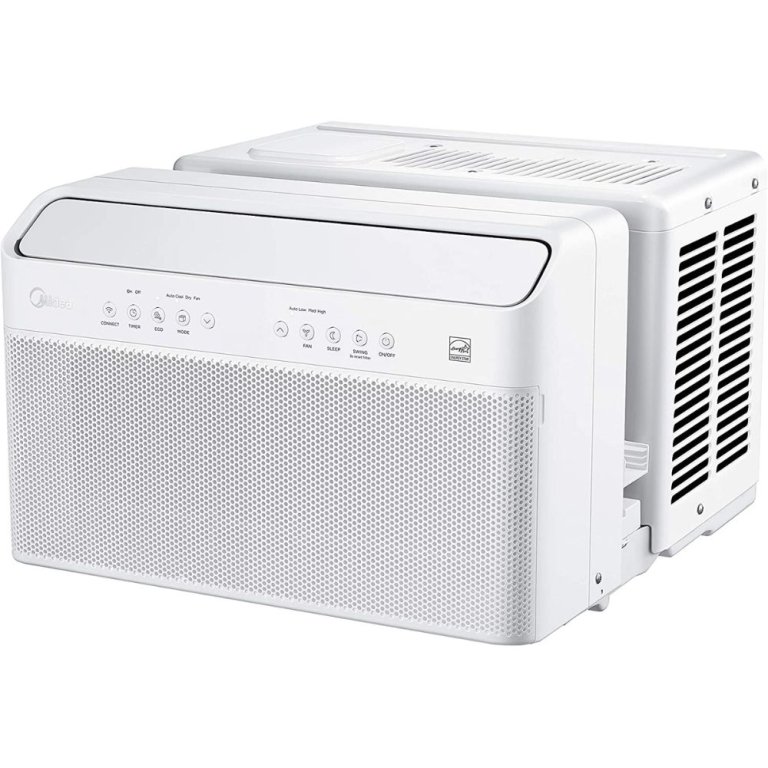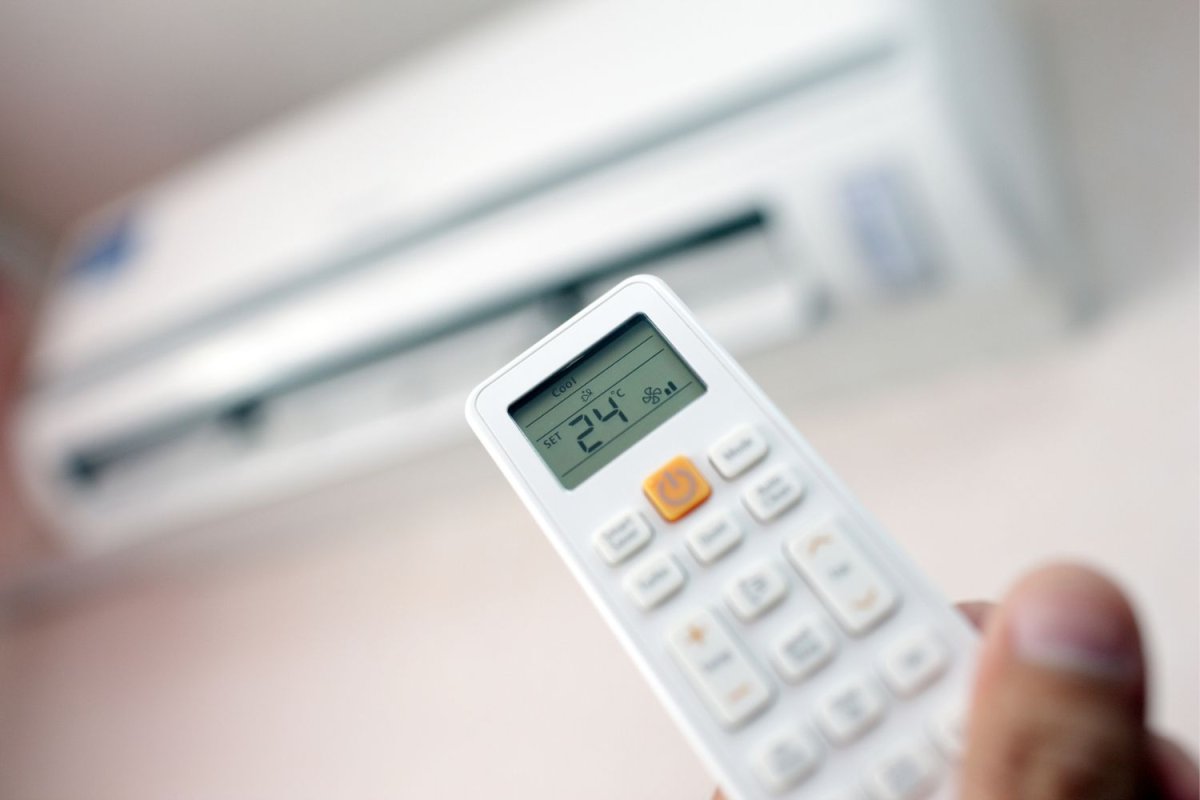
We may earn revenue from the products available on this page and participate in affiliate programs. Learn More ›
If you need relief from those hot summer days but your traditional AC unit is driving up your utility costs, it’s time to upgrade to an energy-efficient air conditioner. The average window air conditioner uses 900 watts of energy per hour, while a central air conditioning unit can use upward of 3,000 watts per hour on hot days. At the average utility rate of 10 cents per kilowatt-hour, a central AC unit can add as much as $90 to your monthly utility bill.
Fortunately, there are energy-efficient models that can slash those utility expenses. These Energy Star–certified air conditioners use smart technology, inverters, and other cutting-edge technologies to decrease the amount of energy an air conditioner uses. With a Seasonal Energy Efficiency Ratio (SEER) rating of 28 and smart features that make it easy to optimize its operation, the Lennox SL28XCV Air Conditioner is our recommended choice for most people. Read on to learn more about what makes an air conditioner energy efficient, and don’t miss our list of the best energy-efficient air conditioners on the market, some of which we even tested.
- BEST OVERALL: Lennox SL28XCV Air Conditioner
↓ Jump to Review - RUNNER-UP: Amana AVXC20 Air Conditioner
↓ Jump to Review - BEST BANG FOR THE BUCK: Keystone Energy Star 5,000 BTU Air Conditioner
↓ Jump to Review - BEST WINDOW UNIT: LG 14,000 BTU Dual Inverter Window Air Conditioner
↓ Jump to Review - BEST MINI-SPLIT: MrCool DIY 4th Gen Mini-Split Air Conditioner
↓ Jump to Review - BEST PORTABLE: Whynter ARC-14S 14,000 BTU Portable Air Conditioner
↓ Jump to Review - BEST THROUGH-THE-WALL: Frigidaire 8,000 BTU Built-In Air Conditioner
↓ Jump to Review - BEST INVERTER: Midea 8,000 BTU U-Shaped Air Conditioner
↓ Jump to Review

Our Top Picks
The models below are some of the best air conditioners on the market for energy efficiency. They are Energy Star certified and loaded with features that will help you regulate their use for maximum energy savings.
Best Overall
Lennox SL28XCV Air Conditioner
What We Like
- High SEER rating
- Quiet operation thanks to inverter compressor
- Works with Lennox’s iComfort S30 smart thermostat
What We Don’t Like
- One of the most expensive AC units on the market
Product Specs
- Energy efficiency: 28 SEER
- Type: Split with inverter compressor
- British thermal units (BTUs): 22,400 to 57,000
The SL28XCV takes over for Lennox’s XC25, which had been widely regarded as being the most energy-efficient central AC unit money could buy with its 26 SEER rating. The SL28XCV takes it up a notch by achieving sky-high efficiency ratings of 28 SEER and 17.6 EER, thanks to a variable-speed inverter compressor. Those ratings put it well above the government’s minimum efficiency rating of 14 SEER for Energy Star–certified air conditioners.
Additionally, a user can cut costs even further by pairing the SL28XCV with Lennox’s iComfort S30 smart thermostat to program on/off times and set schedules. The inverter compressor also has the added benefit of being quieter than most AC units, registering at just 56 decibels. And while the high efficiency comes with a high price tag, the Lennox can make up for those costs fairly quickly in energy savings, as the SL28XCV is 63 percent more efficient than a 10 SEER unit. The SL28XCV comes in four sizes ranging from 22,400 to 57,000 BTUs.
Get the Lennox energy-efficient air conditioner through a Lennox dealer.
Runner-up
Amana AVXC20 Air Conditioner
What We Like
- High SEER rating of 24.5
- Comes with ComfortBridge technology
- Quiet-operation design
What We Don’t Like
- Expensive up-front cost
Product Specs
- Energy efficiency: 24.5 SEER
- Type: Split air conditioner
- BTUs: 24,200 to 53,000
Amana’s Energy Star–certified AVXC20 ranks as one of the most efficient central air conditioners on the market, thanks to its 24.5 SEER rating. Like other high-efficiency air conditioners, Amana achieves this rating with an inverter varied-speed compressor that keeps energy use low. The AVXC20 is also equipped with Amana’s ComfortBridge technology, which automatically makes adjustments based on an analysis of HVAC system performance data, minimizing the amount of energy used.
In addition to being energy efficient, the AVXC20 is quiet. Depending on the unit’s size, the decibel ratings range from 59 to 75. Its design includes a sound-reduction cover consisting of high-density foam.
Get the Amana energy-efficient air conditioner through an Amana dealer.
Best Bang For The Buck
Keystone Energy Star 5,000 BTU Air Conditioner
What We Like
- Excellent EER
- Remote control with integrated thermostat for even cooling
- Programmable on/off timer
What We Don’t Like
- Only suitable for smaller rooms
Product Specs
- Energy efficiency: 12.1 Energy Efficiency Ratio (EER)
- Type: Window air conditioner
- BTUs: 5,000
The operating modes and energy-efficiency rating of this small window air conditioner make it an excellent option for anyone needing an affordable way to cool a single room. With its 12.1 EER rating, this Keystone model might be the best room air conditioner on the market. In addition to its Energy Star certification, it features operating modes that allow it to cut even more energy costs, including an energy-saver mode and an on/off timer the user can program to turn it off when the room is not in use.
At 5,000 BTUs, the Keystone is capable of cooling spaces up to 150 square feet, making it one of the best small air conditioner options on the market. It also comes with a remote control that doubles as the unit’s thermostat, making it easier to operate while also ensuring an even temperature throughout the space.
Get the Keystone energy-efficient air conditioner at Amazon, The Home Depot, or Walmart.
Best Window Unit
LG 14,000 BTU Dual Inverter Window Air Conditioner
What We Like
- Energy Star certification saves energy and cost
- Wi-Fi ready; can be adjusted via smartphone app
- Produces just 44 decibels of noise on sleep setting
What We Don’t Like
- Large size may not fit some windows
Product Specs
- Energy efficiency: 14.7 Combined Energy Efficiency Ratio (CEER)
- Type: Window air conditioner
- BTUs: 14,000
Despite its large 14,000 BTU output, which is enough to cool an 800-square-foot room, this window AC unit is efficient enough to earn a 14.7 CEER. And, since dual-inverter compressors operate more quietly than standard compressors, the LG is one of the quietest window air conditioning units on the market, producing just 44 decibels when set to sleep mode.
With its smooth front, LG’s 14,000 BTU AC unit is also one of the sleeker-looking air conditioners on the market. It’s Wi-Fi ready and uses LGThinQ technology, which allows the user to control the air conditioner from virtually anywhere via the compatible app.
Get the LG energy-efficient air conditioner at Amazon.
Best Mini-split
MrCool DIY 4th Gen Mini-Split Air Conditioner
What We Like
- High SEER rating
- Wi-Fi connectivity allows for smartphone control
- Follow Me function promotes even cooling
- Design for DIY installation
What We Don’t Like
- Pricier than similar units
Product Specs
- Energy efficiency: 22 SEER
- Type: Mini-split
- BTUs: 18,000
While this Energy Star–certified air conditioner’s 22 SEER efficiency rating is impressive, what really sets this 18,000 BTU AC unit from MrCool apart from other energy-efficient mini-splits is its smart connectivity. It can connect to Wi-Fi, allowing the user to turn the air conditioner off or on, set schedules, and adjust the temperature—all via a smartphone. It’s also compatible with Google Assistant and Amazon Alexa, and there’s a wall-mounted thermostat and remote control.
The device’s Follow Me function allows it to sense temperatures through the remote for more even cooling. This unit is also ideal for those who don’t care to pay installation charges: It’s DIY ready with lines that are precharged with freon and fitted with quick connectors that make it easy to install.
Get the MrCool energy-efficient air conditioner at The Home Depot or MrCool DIY Direct.
Whynter ARC-14S 14,000 BTU Portable Air Conditioner
What We Like
- Can cool larger spaces
- Sleek design and digital controls
- Auto-drain technology creates more efficient cooling
What We Don’t Like
- One of the most expensive portable air conditioners
Product Specs
- Energy efficiency: Not rated
- Type: Portable
- BTUs: 14,000
One won’t find any Energy Star–rated portable air conditioners—the federal government doesn’t include them in the program—but if they did, Whynter’s ARC-14S would certainly deserve the rating. It’s the best energy-efficient portable air conditioner on the market. This is due in large part due to its use of auto-drain technology, a process that recycles moisture collected during the cooling process to create more cool air, and the use of two exhaust hoses, a design that improves its ability to create cool air.
Those technologies give the ARC-14S an impressive 14,000 BTUs, enough to cool up to 500 square feet. In addition to being powerful and efficient, the ARC-14 also isn’t the eyesore that some portable air conditioning units are, thanks to its sleek black design and digital controls. Despite weighing 100 pounds, the ARC-14S remains movable as a result of four ample casters that allow it to be rolled from room to room.
What our tester says: Tom Scalisi, Bob Vila writer and product tester, notes in The Best Air Conditioners that “while it’s a bit of an armful, we found that the wheels were a big help with moving it about. It set up quickly in our 600-square-foot room (slightly larger than it’s rated for) and it had the ability to cool the room in just 10 minutes. We also appreciated its slim design, a great difference from bulkier, more traditional portable air conditioners.
Get the Whynter energy-efficient air conditioner at Amazon, The Home Depot, or Wayfair.
Frigidaire 8,000 BTU Built-In Air Conditioner
What We Like
- Includes remote control with thermostat
- Multiple modes for energy savings
- Quick-cool function rapidly chills a room
What We Don’t Like
- More expensive than comparable models
Product Specs
- Energy efficiency: 10.6 CEER
- Type: Through-the-wall
- BTUs: 8,000
With its Energy Star certification, this 8,000 BTU air conditioner from Frigidaire is a great option for those looking for a through-the-wall option. It comes with a remote control that allows the user to set specific thermostat temperatures or engage one of its many modes. It also comes with an energy-saver mode and a timer that allows the user to program the unit to automatically turn off or on.
A 280-cubic-feet-per-minute fan provides ample circulation for this AC unit, which can cool larger rooms up to 350 square feet. The thermostat located in the remote control allows for more even cooling throughout the room.
Get the Frigidaire energy-efficient air conditioner at Amazon.
Midea 8,000 BTU U-Shaped Air Conditioner
What We Like
- High 15 CEER rating
- Quiet operation
- Wi-Fi equipped
- Mounting style allows the window to open and close.
What We Don’t Like
- More expensive than other 8,000 BTU models
Product Specs
- Energy efficiency: 15 CEER
- Type: Window
- BTUs: 8,000
This 8,000 BTU window air conditioner uses inverter technology, which varies the flow of energy to the unit based on demand, to achieve an impressive 15 CEER rating. That translates to 35 percent more energy savings over standard window air conditioners. Inverter technology also makes the unit much quieter, with operating noise levels as low as 42 decibels.
This U-shaped air conditioning unit allows a window to close significantly farther than traditional window AC units would allow, helping to limit air loss. This novel design has the added benefit of allowing the window to be opened without uninstalling the air conditioner. And, since it’s Wi-Fi equipped, the user can control the unit and set on/off schedules remotely via an app.
What our tester says: Tom Scalisi, Bob Vila writer and product tester, notes in our tested guide that “though installation certainly took some effort—it comes with several small components and hardware—once installed, this machine was easy to enjoy. It was so quiet that it was barely noticeable, and it cooled our room by 5 degrees Fahrenheit in just 15 minutes. We also found all of the control methods very easy to use and understand. The control panel is straightforward and using the remote is a snap.”
Get the Midea energy-efficient air conditioner at Amazon, The Home Depot, or Walmart.
Jump to Our Top Picks
How We Chose the Best Energy-Efficient Air Conditioners
We used a variety of criteria to review more than two dozen air conditioners of all types. Given that our goal was to include the best energy-efficient models, we limited our search to those with Energy Star certification. Of those Energy Star–certified models, we leaned toward the ones with the highest energy efficiency scores.
We also favored those with features such as Wi-Fi connectivity and timers that allow the user to further control air conditioning costs by ensuring the unit isn’t running at full capacity when the room is unoccupied. While cost wasn’t a primary factor, we did favor energy-efficient air conditioners that offer the best bang for the buck.
What to Consider When Choosing the Best Energy-Efficient Air Conditioner
Air conditioners are assigned energy-efficiency ratings that are helpful when shopping for the best home air conditioner. Ahead, learn about the three types of energy-efficiency ratings and other important factors to consider when choosing the best AC unit, including size, BTUs, and smart capability.
Types of Energy-Efficient Air Conditioners
From central AC to portable models, air conditioning units come in various shapes and sizes to suit different needs. Read about the many types of AC units here.
Split Air Conditioners
A split air conditioner, often referred to as a central air conditioner, pairs a compressor and condenser placed outside the home with an indoor unit that consists of the evaporator, air handler, and filters. This type of system uses ductwork that runs throughout the house to cool all living areas in the home.
Packaged Air-Conditioning Systems
A packaged air-conditioning system consists of a compressor, coils, and air handler that are all located in a single metal cabinet. This design saves indoor space by housing all the AC’s components outside. Similar to a split air conditioner, a packaged air conditioner distributes the cold air it creates through a network of ducts.
Window Air Conditioning Units
A window air conditioning unit consists of a metal box that contains all the components of an air conditioner: compressor, coils, and air handler. The box is mounted between the sash and sill of a window and works by drawing air in from a room, cooling it, then recirculating the chilled air to cool a single room. Warm air and moisture that the window AC creates as a byproduct of the cooling process is expelled outside.
Portable Air Conditioners
Portable air conditioners consist of a stand-alone unit that houses a compressor, coils, and fan that sits on wheels. The portable AC unit draws air in, cools it, then redistributes it back into the room. Since portable air conditioners do not sit in a window, they have hoses that must be attached to a window to vent the warm air and moisture it creates.
Ductless Mini-Split Air Conditioners
A ductless mini air conditioner has a compressor condenser outside of the home that connects to a small air handler inside one room of the home to cool that particular space.
Through-the-Wall Air Conditioners
Through-the-wall air conditioners are very similar to window air conditioners in their construction. Rather than mount to a window, through-the-wall air conditioners mount to an opening in an exterior wall. This type of AC is ideal for those who want to preserve the windows in a room.
Inverter Air Conditioners
Inverter air conditioners include some ductless, through-the-wall, window-mount, split-air, and over-the-sill conditioners. This type of unit includes an inverter that regulates the amount of electrical current an AC unit receives. Whereas a standard AC unit provides 100 percent of the air conditioner’s wattage whenever the compressor is running, an inverter regulates output in small increments, only giving the compressor the amount of energy it needs to cool the room. This design makes the AC unit’s compressor up to 40 percent more energy efficient than a standard air conditioner cool the room. This design makes the AC unit’s compressor up to 40 percent more energy efficient than a standard air conditioner.
Size and Square Footage
Finding the right-size AC unit to suit the space is critical. An overly small air conditioner will run constantly to try to keep the temperature cool. An air conditioner that’s too large will cool the space too quickly, turning on and off in short bursts that put undue wear on the compressor. With this in mind, it’s crucial to make sure the cooling capacity of the air conditioner suits the square footage of the space it’s cooling by looking at its BTU rating.
BTUs
BTU, or British thermal unit, is a measure of how much heat an air conditioning unit removes from a home in 1 hour. An AC unit’s BTU measurement is crucial for determining what size air conditioner is needed for a home or room. Air conditioners need about 20 BTUs for each square foot of living space. This means an 8,000 BTU window air conditioner is suitable for a 400-square-foot room; a 54,000 BTU central AC unit can cool up to 2,700 square feet.
Temperature and Energy-Efficiency Settings
Air-conditioning units vary the sophistication of their temperature controls. Split air conditioners and most mini-split AC units connect to thermostats that allow the user to dial in specific temperature settings. While some window and through-the-wall models also allow for specific temperature settings, some lower-end units have less-specific “high” and “low” settings.
Some window air conditioners also have energy-saver modes that reduce the amount of power the AC unit uses. When in this mode, the air conditioner alternates between cooling mode and fan-only mode, reducing the amount of electricity the air conditioner uses but also reducing its cooling power.
High Energy-Efficiency Ratings
Several ratings are used to delineate how energy efficient an air conditioner is. The EER, or Energy Efficiency Ratio, measures how efficiently an air conditioner operates and is determined by dividing the air conditioner’s BTU rating by its wattage. The higher an air conditioner’s EER, the more efficient it is.
The CEER, or Combined Energy Efficiency Ratio, is the standard by which the Department of Energy rates the energy efficiency of window-mount air conditioners. The rating reflects a window AC unit’s energy use when it’s running and when it’s in standby mode.
The SEER, or Seasonal Energy Efficiency Ratio, is the rating most commonly used to measure the efficiency of central air conditioners, also known as split air conditioners. SEER ratings measure how well an AC unit will cool the home for an entire season. The higher an air conditioner’s SEER rating, the more efficient it is. The average central AC unit has a SEER rating of around 12; energy-efficient models might have a SEER rating of 14 or higher.
The best AC units have an Energy Star certification, which means the air conditioner meets federal guidelines for energy efficiency. Most Energy Star–certified window air conditioners must have an EER of around 12, which is significantly higher than the 8.5 EER rating the average AC window unit has. A central air conditioner must have a SEER rating of at least 14 to qualify for an Energy Star certification.
Wi-Fi–Enabled/Smart Features
Many air conditioning units are able to connect to a home’s Wi-Fi network, enabling smart features. Users can control a Wi-Fi–enabled air conditioner via an app on a smartphone, scheduling on and off times as well as temperature changes. While these features add to the up-front cost of an air conditioner, they also improve its energy efficiency by allowing the user to turn the AC off or bump the thermostat up a few degrees when the room or home is not in use.
Understanding how to maintain and operate an air conditioner to get the most out of it is key to keeping that utility bill in check during the summer months. Ahead, learn about the most efficient way to run an air conditioner and learn how upgrading your aging AC unit to a newer model can save you money.
FAQs
A new air conditioner generally uses less electricity because it is more technologically advanced than older models. Air conditioner compressors also cool less efficiently as they get older, forcing them to work harder and use more energy to cool the room.
There are several ways to reduce the power consumption of an air conditioner. The most obvious is turning up the thermostat to a higher temperature. Clean the air conditioner and replace the filter regularly to ensure the air conditioner is in peak condition. If possible, switch to a smart thermostat that allows you to schedule on/off times for the air conditioner so it isn’t running when it doesn’t have to.
It is cheaper to leave the air conditioner on all day if it’s hot outside. Turning off the air conditioner during hot and humid weather can quickly cause heat and humidity to build up in the home. This places a strain on the air conditioner to cool the home when you turn it back on. A better option is to adjust the air conditioner by a few degrees when you’re not home.
Fans are much cheaper to operate than air conditioners because they do not use a compressor. It’s a good idea to use fans in combination with air conditioners to make the air feel cooler, allowing you to increase the thermostat a few degrees.
A 20-year-old air conditioner is much less efficient than today’s models. An older air conditioner may use 6 kilowatt-hours of electricity to cool an average house, while a modern system can use less than 2 kilowatt-hours to cool the same space.
A mini-split air conditioner is much more efficient than a window unit. The average mini-split consumes 40 percent less energy than a window air conditioner to cool the same space.
It depends on what you’re trying to cool. If your goal is to cool a single room, then a window air conditioner is the best option. If you need to cool an entire home, it’s more economical to use a central air conditioner than placing a window unit in every room of the home.
Understanding how to maintain and operate an air conditioner to get the most out of it is key to keeping that utility bill in check during the summer months. Ahead, learn about the most efficient way to run an air conditioner and learn how upgrading your aging AC unit to a newer model can save you money.
A new air conditioner generally uses less electricity because it is more technologically advanced than older models. Air conditioner compressors also cool less efficiently as they get older, forcing them to work harder and use more energy to cool the room.
There are several ways to reduce the power consumption of an air conditioner. The most obvious is turning up the thermostat to a higher temperature. Clean the air conditioner and replace the filter regularly to ensure the air conditioner is in peak condition. If possible, switch to a smart thermostat that allows you to schedule on/off times for the air conditioner so it isn’t running when it doesn’t have to.
It is cheaper to leave the air conditioner on all day if it’s hot outside. Turning off the air conditioner during hot and humid weather can quickly cause heat and humidity to build up in the home. This places a strain on the air conditioner to cool the home when you turn it back on. A better option is to adjust the air conditioner by a few degrees when you’re not home.
Fans are much cheaper to operate than air conditioners because they do not use a compressor. It’s a good idea to use fans in combination with air conditioners to make the air feel cooler, allowing you to increase the thermostat a few degrees.
A 20-year-old air conditioner is much less efficient than today’s models. An older air conditioner may use 6 kilowatt-hours of electricity to cool an average house, while a modern system can use less than 2 kilowatt-hours to cool the same space.
A mini-split air conditioner is much more efficient than a window unit. The average mini-split consumes 40 percent less energy than a window air conditioner to cool the same space.
It depends on what you’re trying to cool. If your goal is to cool a single room, then a window air conditioner is the best option. If you need to cool an entire home, it’s more economical to use a central air conditioner than placing a window unit in every room of the home.
